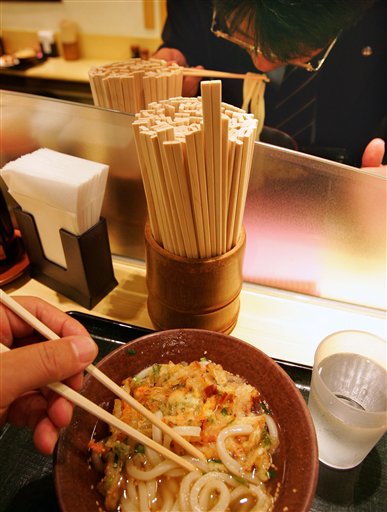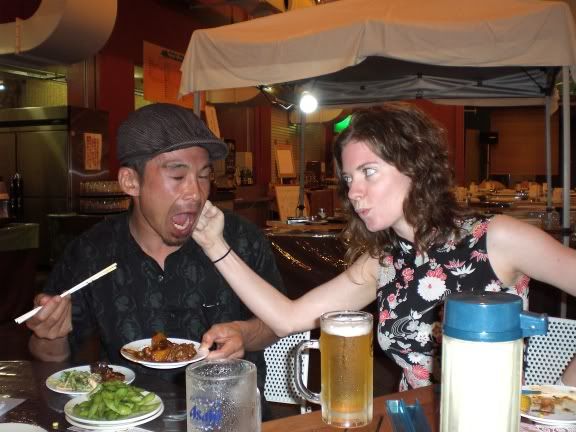so i’ve decided to hug this tree for a minute…
i first became concerned about this at the fuji rock festival last july, although it took another year for me to make a real stand.

disposable chopsticks, given away to patrons by the millions each day in convenience stores, grocery stores and restaurants, are a real national problem.
when i moved into my apartment, i inherited a junk drawer packed full of the utensils cobbled together from various venues, according to their yellowed wrappers. you can buy them at the 100 yen store for 1 yen a pair. in a country that mandates recycling and is so anal about the exact sorting of garbage, how can they so carelessly throw away more than 25 billion pairs of wooden chopsticks a year?

the answer’s multi-fold according to everything i’ve read and been told over the course of my very serious and scientific exploration of this topic. a time magazine article called japan’s addiction to disposable chopsticks “the ultimate indication of its success…. The use of disposable chopsticks surged in the late 1970s and through the 1980s. They were a symbol of national growth that meant people were eating out more frequently, and of a culture that was wealthy enough to pander to an obsession with hygiene.”


After becoming preoccupied with this so obviously wasteful habit, i began asking around and found that hygiene tops many people’s list of excuses for using wooden chopsticks, or waribashi in japanese. at a friend’s sushi bar, during a discussion of this matter, he emerged from the kitchen with 3 beautiful, lacquered chopsticks and explained to me that one was from his mother’s pair, one was from his father’s pair and the last was his. even in family homes, they never use chopsticks that have touched someone else’s mouth. i laughed out loud to think how many japanese guests i’ve had in my home, and each time, their place was set with whatever pair of chopsticks happened to be clean at the moment. they were probably horrified but remained silent about their misgivings, as that is typically the japanese way to approach a problem in which someone runs the risk of being embarrassed or losing face. at hase’s ramen shop i always disdainfully eye the hundreds of pairs of disposable chopsticks standing in metal tubs that dot the counter. he’s a shrewd business man, so i tend to believe his insights and intuitions about all things financial. he promises that he would lose a significant amount of business if he quit providing the throwaway sticks. according to time magazine, “marché, a chain of more than 760 izakaya japanese restaurants in the osaka area, has switched to plastic chopsticks, which are washed and reused in all its branches. A spokesman said that in recent weeks the company had been flooded with requests from restaurants, convenience stores and makers of bento lunchboxes asking to know what customers’ reaction had been.”

this omnipresent hygiene argument buckles under examination though. at hase’s shop, right next to the waribashi, are baskets of plastic spoons used to ladle the ramen broth into one’s mouth. the irony isn't lost on my japanese friends; they readily admit it makes no sense that these utensils are considered washable and reusable, but plastic chopsticks aren’t. “There are going to be people who object even when they know the chopsticks have been washed properly,” a spokesman for kokusai kako, a japanese company that makes plastic chopsticks said. “It’s a sort of mental problem.” the same friends also confess that if a restaurant didn’t offer disposable chopsticks, they’d bring their own before they’d touch a pair of sticks that had touched someone else's lips. that sounds like a cue to restaurant owners and food providers if you ask me.
another explanation proffered up is cost. they are simply so cheap that it’s not fiscally responsible to invest in reusable pairs. friends have told me that commercially they can buy waribashi for as cheap as 2 pairs for 1 yen. unfortunately, at this price, it’s also not fiscally responsible to recycle the used wooden sticks. throwing away the chopsticks also means employers aren’t paying wages to employees for time spent washing the utensils.
93% of disposable chopsticks used in this country are imported from china. environmental concerns of deforestation have lead the chinese government to increase taxes on disposable chopsticks and it looks like more export tax hikes are on the way. according to time magazine, beijing is reportedly considering an end to all chopstick exports in 2008. now all sorts of alternatives to the white birch chopsticks are being entertained. importing from other countries, such as vietnam, is no where near as cheap, which is the same problem posed by purchasing disposable sticks made in japan. chopsticks made of bamboo and recycled paper are now being studied for their feasibility. if that doesn’t pan out, i guess we could just all make art and furniture out of ‘em.
click the pic to find out more about the waribashi project in san fran.

i used this topic to spark discussion in a recent adult english class and i couldn’t believe how nicely the debate heated up. one student suggested that handsome, decorative chopsticks might make patrons more likely to go along with reusing them. this idea was quickly struck down when the rest of the class agreed that sleek, lacquered beauties instead of beat-up, cheap plastic ones still wouldn't convince them to reuse the sticks. plus the cost of fancy chopsticks dictates most restaurants wouldn’t provide ‘em. one viable suggestion was offering a few yen discount to patrons who choose to bring their own utensils or refuse them at convenience stores, similar to the plastic grocery bag scheme in some countries. the idea of charging a few more yen if someone asks for disposable chopsticks was rejected outright based on the belief any hike in prices would drive customers away. there weren’t any real good suggestions offered on how to go about changing the mindset that anchors this problem into japanese society. hase thinks a campaign by the government would be the best way to push this issue into the public’s agenda and open widespread debate on a solution. the awareness it would spark would also temper reactions to establishments that do the right thing and convert to reusable chopsticks. i’ve actually been embarking on a p.r. campaign of my own recently…
i’ve taken to carrying my own plastic pair of chopsticks in a little case in my bag and i proceed to explain to every student, grandpa and person who gives me a funny look why. surprisingly, they all commend me and say it’s a good idea although they chuckle at the idea of doing it themselves. my washable chopsticks set me back a whopping 100 yen and have already spared hundreds of disposable chopsticks that were undoubtedly wasted on someone else.

this was our 'let's get drunk and be loud and obnoxious cause americans have the freedom to get away with that' 4th of july trip to the beer garden. as you can see by the lack of peeps in the background, no one else in japan really celebrates america's independence. please notice hase's environmentally unfriendly chopsticks and the cute blue case on the table for the plastic ones resting on my plate.

at a recent party, a friend eyed my aqua colored utensils and asked ‘what’s that blue shit?’ hase misunderstood and thought she asked, ‘what’s that bullshit?’ so now that’s how my carry-along chopsticks are affectionately known. “nah, tiffany doesn’t need any, she brought her own bullshit.” no matter how you refer to the handy, reusable utensils, you’ve gotta admit, bringing your own is a good idea.


3 Comments:
Hey you sexy ex-pat. Way to fight the powers that be. I had no idea that disposible chopsticks where such an ingrained social mainstay. Also, I had no idea that the potential envirnmental impact could be so large and troubling.
I think you make a excellent figure to spearhead this sino-spork problem.
Oh and thanks for the shout out to Boots, although it has been a little neglected in our frenzy of traveling and packing to leave the country.
Big Hugs from the West,
L.Pants
Yay Tiff!
I bought a rather fancy pair of camping chopsticks a few months ago, but managed to lose them somewhere. I've been 'making do' with the disposable ones until I make it back to Par Mar to buy a new pair.
But now, I'm off to the 100 yen store to buy a plastic pair before tonight's ramen.
Thanks for the nudge! My little green geek is very happy!
Glad you chose to write about my pet hate in a much more informative way than i could ever manage!
I also got a bit obsessed with this topic (after being shamed into never accepting another pair of disposable chopsticks by Troy if i remember correctly!). Another reason people seem so happy to use them is the common mis-conception that this is 'waste' wood, although nobody ever managed to elaborate on this! Someone once also told me that is helped the Chinese economy along(!).
The junior high school lunches have reusable plastic chopsticks with them though and nobody complains (the teachers use them too).
Hope the move goes well, good luck in sanko!
Melly xxx
Post a Comment
<< Home